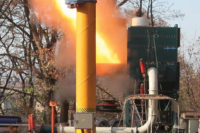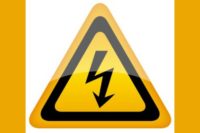 While the most basic function of a dust collector is to keep workers and workplaces safer, not all collectors are created equal from a safety standpoint.
While the most basic function of a dust collector is to keep workers and workplaces safer, not all collectors are created equal from a safety standpoint.
Here are some tips for ensuring that your dust collector is as safe as possible. Consider following these guidelines if you are selecting new equipment – but even if you are only looking to improve an existing system, many of these tips will still prove useful.
1. Look for a dust collector with a higher pressure rating.
Whenever a collector is equipped with an explosion venting or suppression system, as is now required in many industries, vessel strength is an important factor in sizing the explosion protection equipment. A heavy-duty collector, constructed of thicker gauge metal and with a higher pressure rating, will stand up better in the event of a combustible dust explosion. It will also enable you to use a simpler and less costly explosion protection system to comply with NFPA standards.
2. Don’t overlook the ductwork.
Even if a collector has rugged construction and a properly sized explosion vent, you still need to protect the ductwork that serves the dust collector. Ducting should be equipped with dampers and valves designed to minimize the risk of explosion within these components. This is a task that is overlooked with surprising frequency.
3. Never store dust in the hopper.
Make sure your dust collector’s hopper is equipped with a device that discharges the dust into a separate drum or storage container after it is pulsed off the filters during the cleaning process. Equally important, this storage container must be emptied regularly, or dust can back up into the hopper. Dust sitting in a hopper creates a potential fire or explosion risk, and may also affect performance adversely by clogging up the system and preventing the pulse-cleaning system from doing its job.
4. Don’t use a programmable logic controller (PLC) to control pulse-cleaning of filters.
Though PLCs are popular for use with a variety of processes, they are not well-suited to controlling pulse-cleaning of dust collector filter cartridges. Pulse-cleaning relies on very brief (i.e., 150-millisecond), high-energy bursts of compressed air to blow dirt off the filter surfaces. With a PLC, the valve typically opens too slowly for proper pulsing to occur. To optimize cleaning and ensure reliable dust collector operation, use a timer board designed specifically for filter pulsing. The timer board can be used independently or tied into your PLC.
5. Don’t rely solely on filter percentage efficiencies or MERV ratings to predict compliance.
Sometimes equipment suppliers talk about “removing 99.9 percent of contaminants” of a certain particle size, or they state filter efficiency as a MERV rating. The EPA and OSHA don’t care about percentage efficiency claims: They want to know that emissions will be at or below required thresholds. Ask the filtration manufacturer for a written guarantee of emissions performance stated as grains per cubic foot.
6. Consider ease and safety of filter change-out.
The first goal should be no confined space entry – i.e., workers should ideally never have to enter the dust collector to change the filters. Many cartridge-style dust collectors offer this feature, but the giant old-style baghouses still require entry during service, putting workers at risk and requiring companies to file confined space entry permits and monitor for gas.
Ease of filter change-out should be explored. Are the filters positioned for ease of access? Do they slide in and out of the housing readily? Pulling out a dirty overhead filter that weighs 100 pounds can result in neck, back and foot injuries. Threaded connections on the filter access doors or hoppers are also to be avoided, because dust tends to build up in the threads and cause connections to stick. Camlock-style devices are not subject to this problem and make for easier service.
7. Reduce change-out frequency with long-life filters.
No matter how maintenance-friendly a collector may be, the less service needed, the better – especially in hazardous dust applications. Extended-life cartridge filters available in today’s market can reduce replacement frequency – minimizing worker exposure to dust, saving on maintenance and disposal costs, and reducing landfill impact. Some filter suppliers even offer written guarantees on filter life.
8. Optimize fire prevention.
For spark-generating applications, a range of features and technologies are available, from flame-retardant filter media to spark arrestors in the form of drop-out boxes, perforated screens or cyclone devices installed at collector inlets. Fire sprinkler systems may also be required with some installations.
Dust collectors that use vertically-mounted cartridges also reduce fire and explosion risks. With horizontally-mounted systems, dust becomes entrained at the top of the filters, and there is no pre-separation of heavy or abrasive particles from the air stream. This situation can shorten filter life and provide a dusty surface for sparks to ignite. Vertical mounting reduces the load on the filters and helps eliminate these problems.
9. Evaluate needs for additional safety accessories.
OSHA-compliant railed safety platforms and caged ladders can prevent slips and falls when workers access the collector for service. Lock-out/tag-out doors prevent injury caused by inadvertent opening of doors during a pulsing cycle and/or exposure to hazardous dust. Where highly toxic dust is being handled, a bag-in/bag-out (BIBO) containment system may be required to isolate workers from used filters during change-out.
10. Consider a safety monitoring filter.
You might also want to equip your collector with a safety monitoring filter. This is a secondary bank of high efficiency air filters that prevent collected dust from re-entering the workspace if there should be a leak in the dust collector’s primary filtering system.
A safety monitoring filter is a required component in a recirculating dust collection system that recycles air downstream of the collector. By recirculating heated or cooled air back through the plant, the cost to replace that conditioned air is eliminated, with rapid paybacks in energy savings. Another advantage of recirculating systems is a reduction in regulatory paperwork. By containing the air indoors, you can avoid the time-consuming permitting involved when contaminated air is exhausted outside.
Source: Camfil Air Pollution Control


